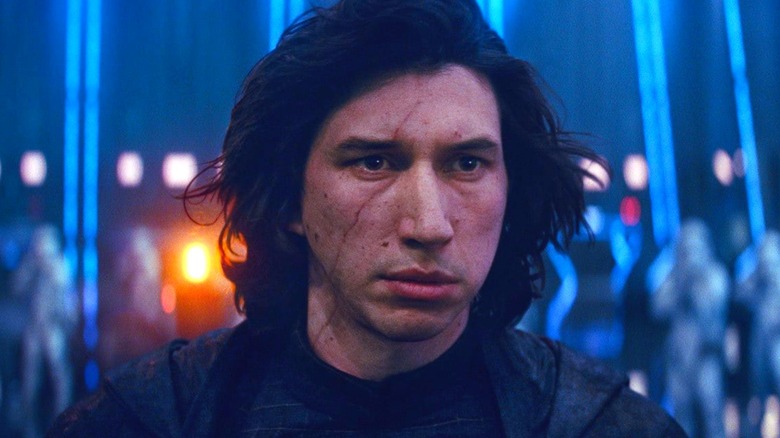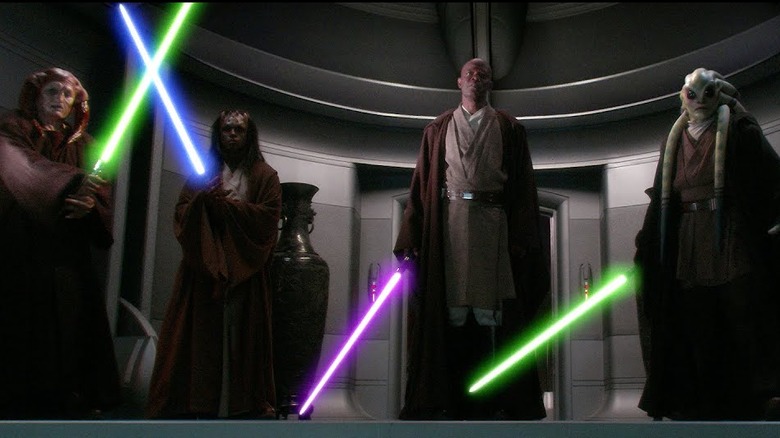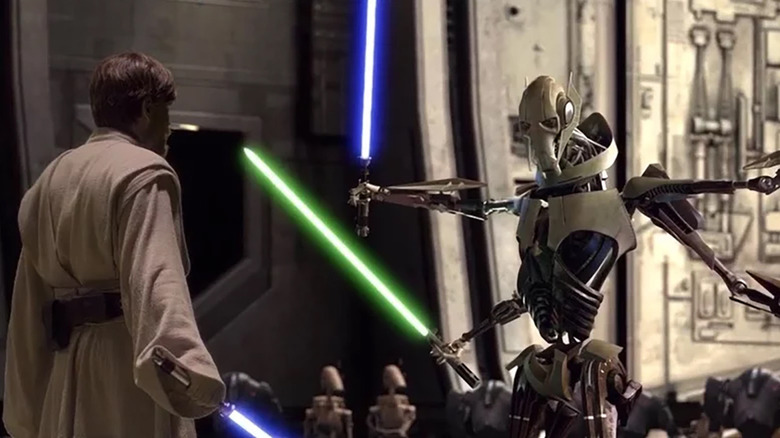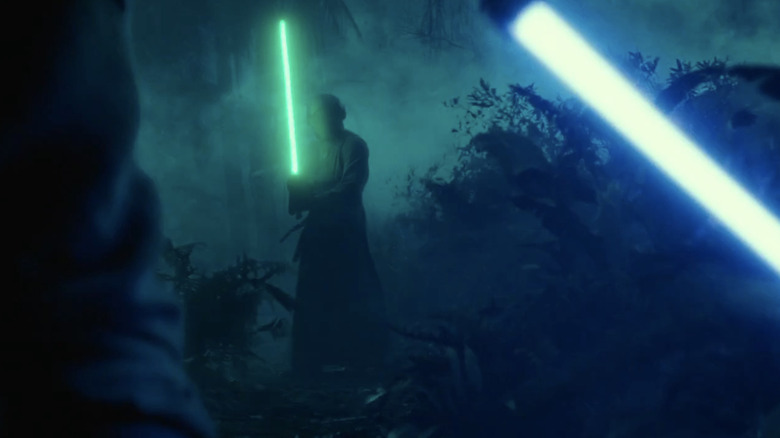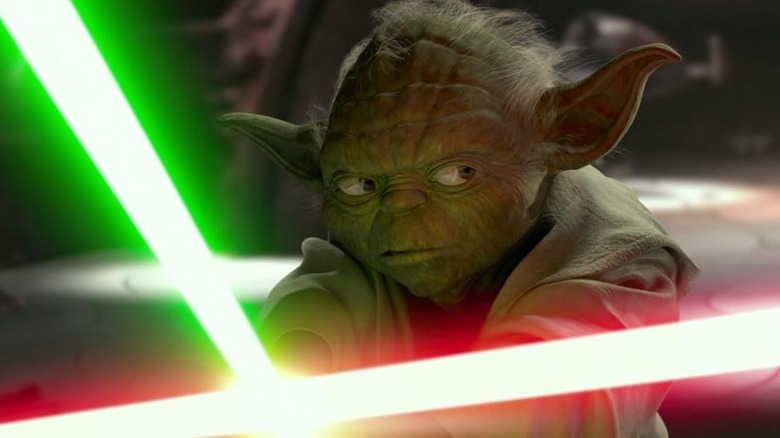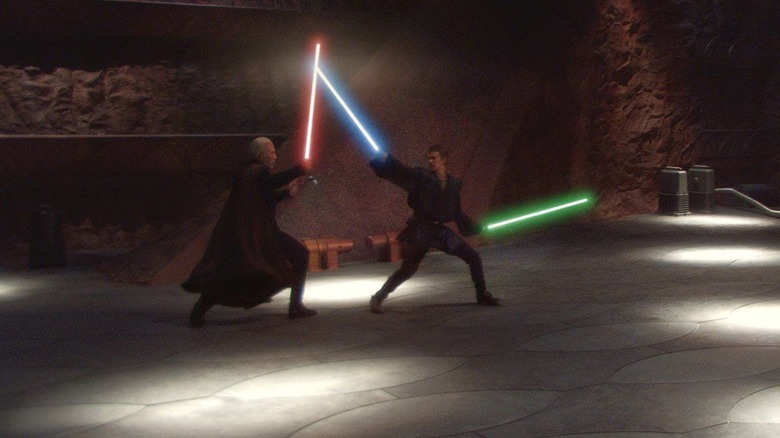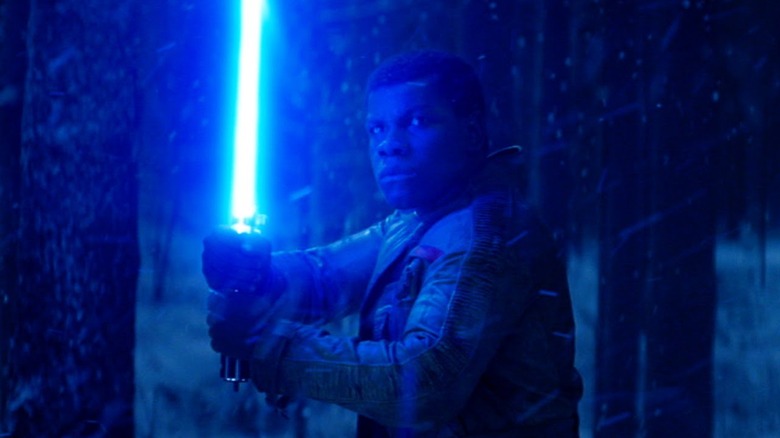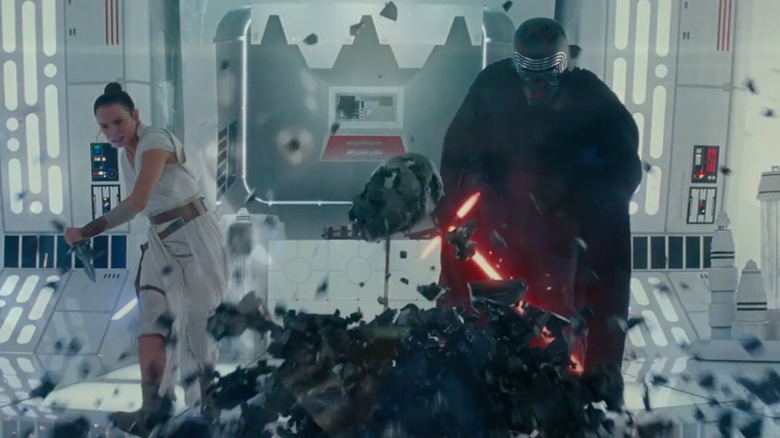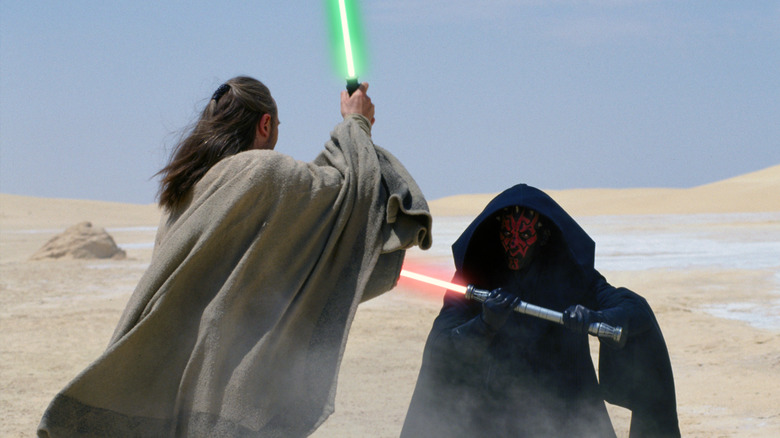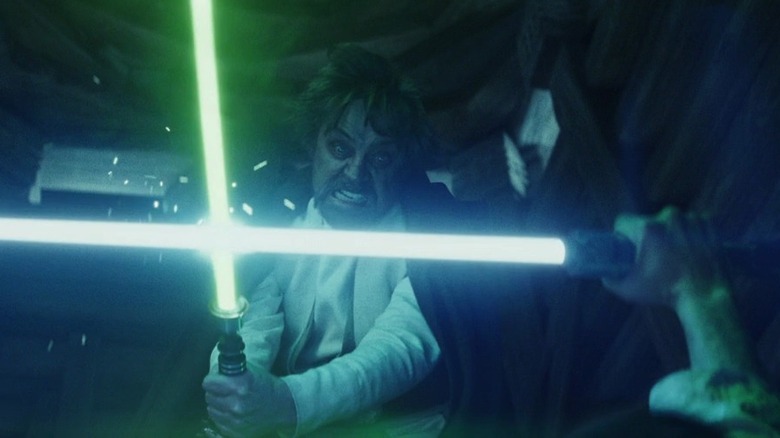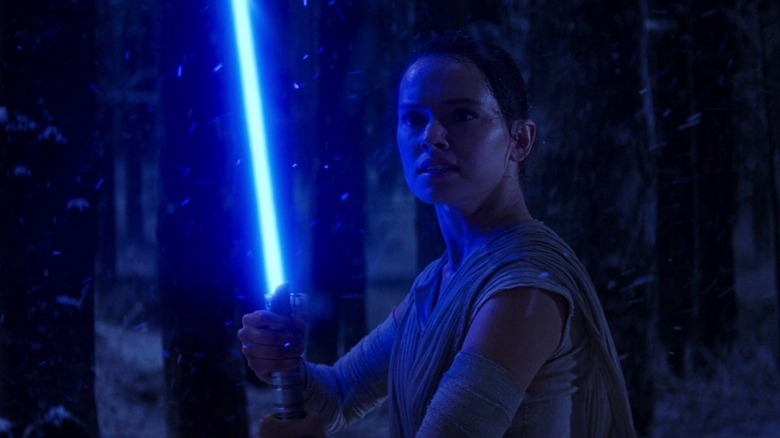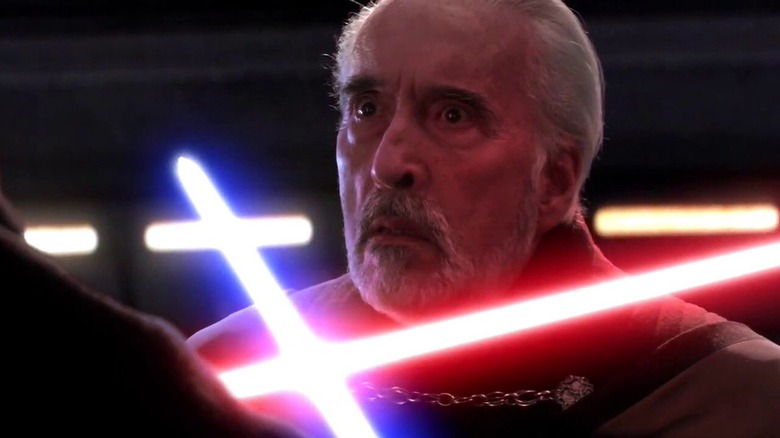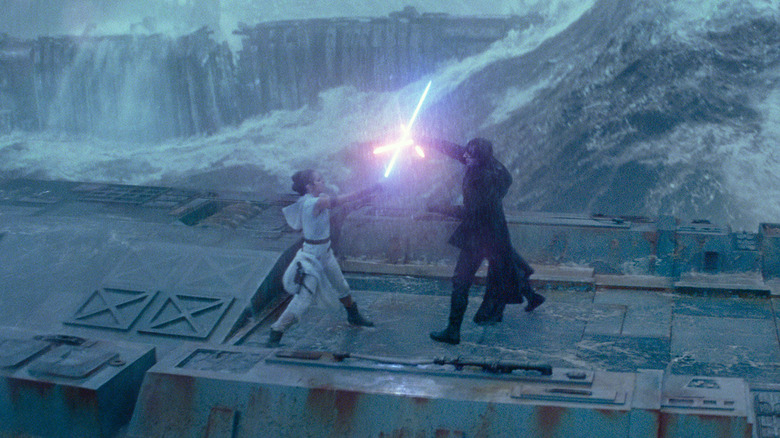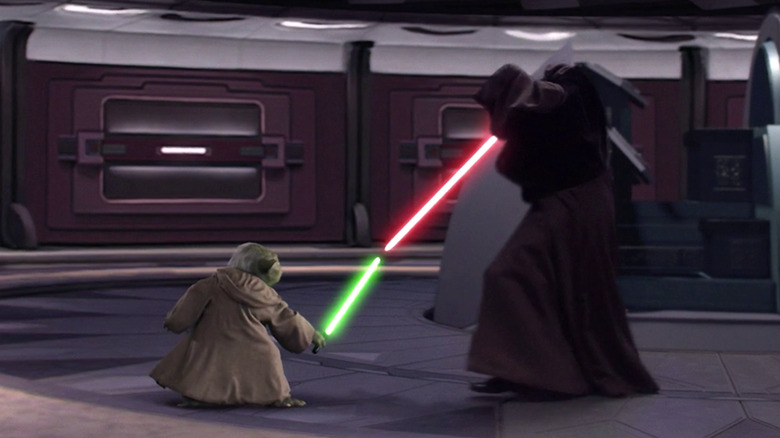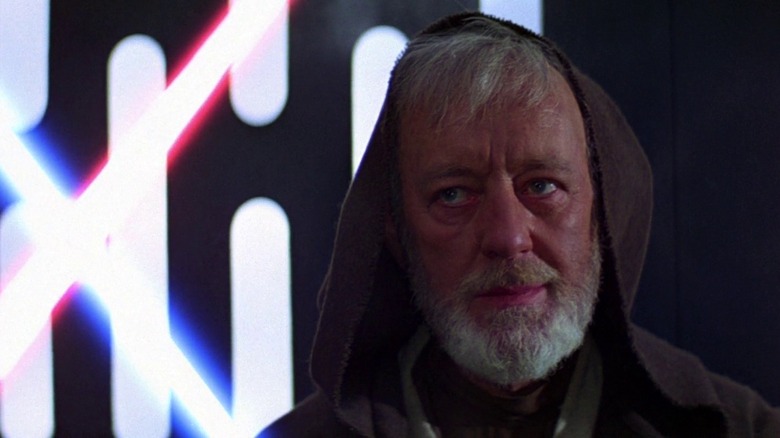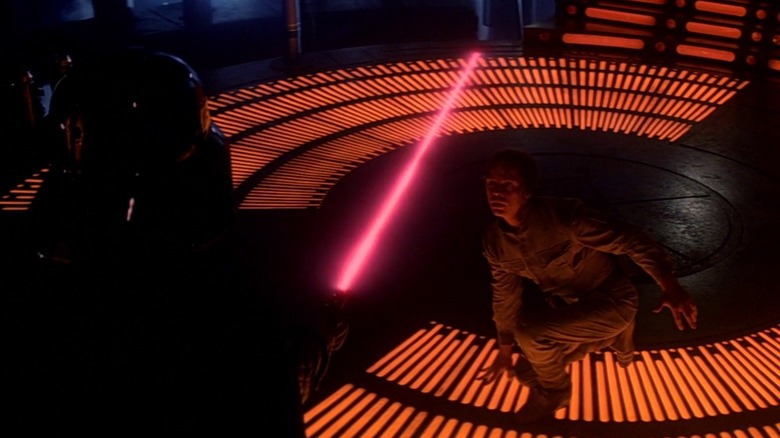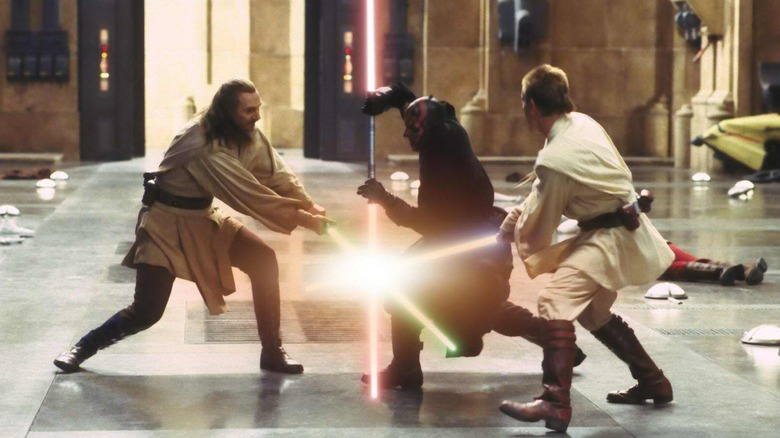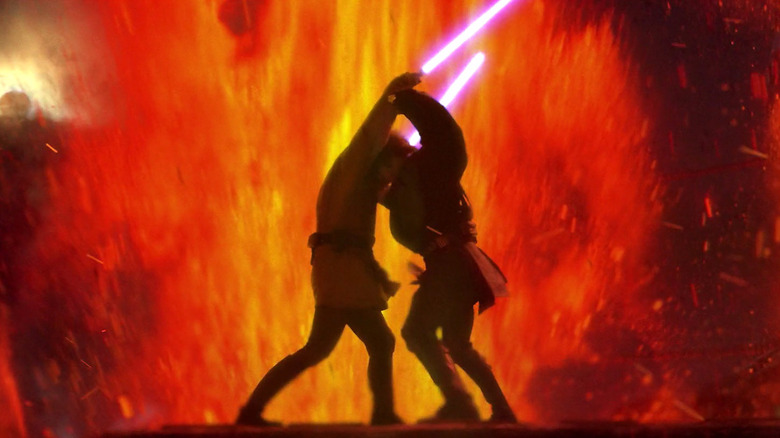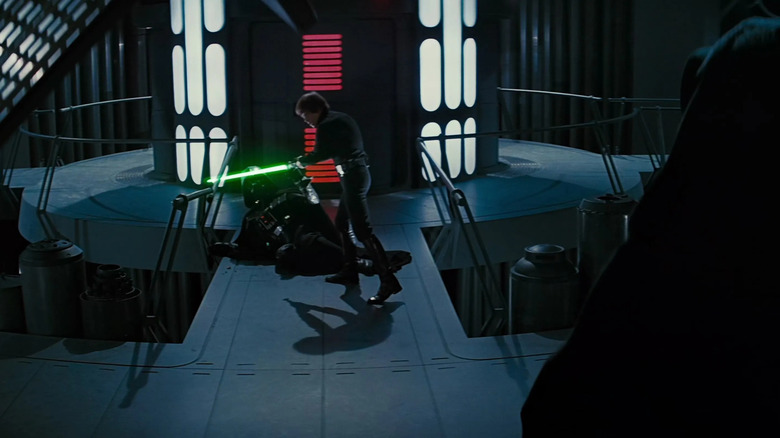Every Star Wars Movie Lightsaber Fight, Ranked Worst To Best
It's a wonder "Star Wars" has such a loyal fanbase, considering that it hasn't universally liked a "Star Wars" movie since 1980. Yet they keep coming back for more, and epic lightsaber duels are a big reason why.
The lightsaber is possibly the most iconic thing the saga has introduced to the world of pop culture. Every kid wants one. Hell, every adult wants one, even more than 40 years after we first saw them in 1977's "A New Hope." Since then, we've been treated to dozens of appearances of the epic sci-fi weapon. It's just not a "Star Wars" movie without one.
The movies are pretty hit or miss when it comes to actual storytelling, with bad films arguably outnumbering good ones. Even in the midst of the lousiest, stupidest, and most mockable "Star Wars" movies, you can expect to see Jedi knights and Sith lords go at it with the laser swords at some point in the story.
We've counted no fewer than 17 instances throughout the 9 main films where characters cross lightsabers, and we've ranked them all here from worst to best. The best ones knock it out of the park in terms of both choreography and emotional impact, but all the duels have something to wow audiences.
Palpatine vs. Mace Windu and the Masters
Sigh. We know why things had to happen the way they did here. It was time to finally bring Palpatine, AKA Darth Sidious, out of the shadows in which he'd been scheming for two and a half movies, and reveal him in-universe as the ultimate Big Bad. How better to do that than by having him effortlessly dispatch a handful of Jedi masters before giving Mace Windu, one of the finest duelists in the "Star Wars" universe, a run for his money? It could've been a masterpiece of a scene that would've filled audiences with terror at the mere mention of Palpatine's name.
Instead, we got some goofy slapstick where Palpatine snarls hilariously and twirls around, and overly choreographs some sloppy, old-man lunges that only find their mark because Jedi Masters Kit Fisto, Saesee Tiin, and Agen Kolar have decided to simply stand in the doorway like chumps and do nothing. The fight between Windu and Palpatine that follows is just as bizarre and unintentionally funny. We understand that neither Ian McDiarmid nor Samuel L. Jackson can perform the rapid-fire blows and parries the scene required, but that's what stunt doubles and CGI are for. It's not like George Lucas ever shied away from either tool.
Much has been said about the failures of the "Star Wars" prequels, but the one arena even critics agree they shined in was lightsaber duel choreography. So we're really not sure what happened with this one.
Obi-Wan vs. Grievous
This "Revenge of the Sith" fight is full of missed opportunities, for both Obi-Wan Kenobi and his opponent, General Grievous, an evil alien cyborg with a bad cough. The first comes moments after Kenobi's iconic and endlessly memed "Hello there!" when Grievous inexplicably tells what looks like an entire field division of battle droids not to shoot because he wants to handle the "Jedi scum" himself. It's already been established that Grievous has no problem using droids to fight for him, or running away when it doesn't go so well, so this makes no sense.
The second missed opportunity is Kenobi's, when he doesn't simply ram his blade through Grievous' face while the General monologues and reveals his four lightsabers: one for every arm he has and each stolen from a murdered Jedi.The third missed opportunity is from Grievous again, when he stops twirling two blades in front of his face like propellers and proceeds to engage Kenobi in a more traditional fight which the Jedi comically dominates. After losing two hands, Grievous runs away. The fight is kind of fun to watch, but it gets dumber the more you think about it. The chase and the final, non-lightsaber fight that follow it are much more thrilling.
The fight doesn't hold up on the storytelling end either. It's obvious that Grievous, and Kenobi's mission to kill him, were only written into the script to separate him from Anakin while the real story happened back on Coruscant.
Luke vs Leia
However one might feel about the "Star Wars" sequel trilogy, just about everyone agrees that the third installment (and the ninth overall film in the Skywalker Saga), "Star Wars: The Rise of Skywalker," is the worst of it. Despite that, the lightsaber battles themselves, by and large, are all fairly impressive. The one exception to that rule is the brief flashback we see after General Leia Organa's death, where the Force ghost of Luke Skywalker explains to Rey that his sister had nearly become a Jedi herself. The scene is incredibly touching and an important moment in Rey's own journey, but the actual duel between Luke and Leia — where Leia quickly overpowers her brother after a short skirmish — leaves a lot to be desired.
Of course, it makes sense that Leia, after being carefully trained in the Jedi arts by her brother, would be able to overpower Luke. She was a fighter from her youth, long before Luke blew up his first Death Star. But that's not the problem with this scene, even if her knocking the Jedi Knight down with a kick feels a bit unsatisfying. Indeed, the issue is that the whole thing is more of a tease of a duel than an actual duel itself. Since the twins aren't actually fighting each other, the stakes are very low, and although it's a nice moment that calls back to the original trilogy, it's not particularly interesting as far as lightsaber battles are concerned.
Yoda vs. Dooku
A good lightsaber fight should excel in terms of both choreography and storytelling. This fight, from "Attack of the Clones," gets a nice score in the former category but a flat-out 0/10 in the latter one, which averages out to a lousy position on this list.
Choreography-wise, the team pulled out all the stops to show Yoda flipping around the room while Count Dooku, who would've broken a hip if he'd tried the same, fell back on his seasoned swordsmanship to survive and was only barely able to keep up. Like many other prequel duels, this one is fantastically choreographed and a lot of fun to watch. If we'd seen this play out as "Star Wars" newbies with no understanding of who these characters were, we'd have been delighted.
However, "Star Wars" geeks know this scene was an insult to Yoda's introduction in "The Empire Strikes Back." His being a pocket-sized alien geriatric wasn't a silly gag, but an important character feature. How could this little guy be one of the mightiest Force-users ever? Yoda subverts all expectations, the right way, by teaching Luke that true strength comes from within, not from the "crude matter" of brute physical ability. His having a lightsaber at all completely defeats the point of Yoda as a character and all the lessons he taught fans in 1980. Worse still, you could cut this scene and the story would lose nothing.
Dooku vs. Anakin and Obi-Wan (round 1)
"Attack of the Clones" is probably the worst "Star Wars" movie of them all. The plot is all over the place and rarely makes sense, and the romantic scenes are achingly bad. The CGI is overused and hasn't aged well. The lightsaber duels are only okay.
In the story, the Battle of Geonosis has ended in a Republic victory. Anakin and Obi-Wan chase Count Dooku to a hangar bay, where he plans to escape and continue the Clone Wars, because begun they have. Well, it's him against two pretty lethal Jedi, so even though he's a master, they should be able to give the guy a run for his money. Right?
Yeah, no. Anakin bungles things by rushing in and getting thrown into the wall with Force lightning. Obi-Wan is now alone and visibly nervous. Dooku, who understands that winning a duel isn't just about better swordsmanship, but getting into the opponent's head, taunts and wounds Kenobi, knocking him out of the fight. Anakin then gets back up after his nap and, in what's easily the scene's best sequence, duels Dooku with both his and Kenobi's blades as the lights flicker. But then Dooku lops off his arm and Force pushes him into a pile with Obi-Wan (don't ask why he severed Anakin's whole limb and only singed Kenobi's, because we have no answer). Anyway, it's all... fine. We guess. It makes Anakin and Obi-Wan look like doofuses, but hey, at least viewers get some Christopher Lee.
Kylo vs. Finn
We're on the fence about this one. The lightsaber duels in the sequels were lightly satisfying. They weren't as flashy as they'd been in the prequels, but the less impressive choreography was more than balanced out by excellent sound design, in which the delicious hums and crackles of the blades were dialed up to an 11, as well as better acting and stronger motivations from the characters involved. Kylo works well here. He's enraged by his own shortcomings, both real and perceived, by his letting his guard town and getting wounded, and by the little tug of the Light side of the Force that he can't seem to rid himself of, even after murdering his own father. This manifests in a rather sloppy performance in his first on-screen duel, against Finn.
Kylo wins it all the same, because Finn is not the Jedi "The Force Awakens" promotional material intentionally tricked fans into thinking he was. And that's where it falters. Finn –- a reformed stormtrooper who learns to fight for something bigger than himself –- had all the makings of an excellent arc. Through him these films could've explored themes of revenge and mercy, charting your own course and how one might deal with a troubled past. Kylo dispatches Finn with ease, setting up the reveal that Rey was the Jedi all along. The fight still works, but Finn, and actor John Boyega, deserved better.
Rey vs. Kylo (round 2)
Rey and Kylo Ren are the only two adversaries who've dueled more than twice in the entirety of the "Star Wars" saga. Maybe it's because they're not very good swordsmen and can't seem to kill each other off, but whatever. Their second duel -– the first in "Rise of Skywalker" –- is probably the weakest, but it's not a total dud. The ideas here are a lot more interesting than the actual fight is, we'll put it that way. That's because the two actually fight in two places at once, using a type of Force projection similar to what Luke used at the end of "The Last Jedi."
In the story, Rey's traveled to the planet Pasaana with Finn, Chewie, Poe, BB-8, and C3P0 in the hopes of finding a Sith Wayfinder that'll lead them to a resurrected Palpatine. Kylo Ren finds her through the Force and heads there with the Knights of Ren. He confronts her, and their fight is heavy and full of a lot more emotion and raw power than sharp swordplay. But that's pretty par for the course with the sequels, so we're not complaining. Using some Force magic, Kylo manages to split the battlefield between two places. J.J. Abrams' logic for this doesn't really hold up, but visually, it all works pretty seamlessly. And the destruction of Vader's burnt helmet –- the one first seen in the "Force Awakens" trailer — makes for some pretty tasty foreshadowing.
Qui-Gon vs Darth Maul
There's not much to like or dislike about this "Phantom Menace" fight, which pits Qui-Gon Jinn against Darth Maul in the sands of Tatooine, when the good guys are about to depart the planet with a young Anakin. The duel is brief, offering only a taste of the epic deathmatch that fans see later in the movie, between these two and Qui-Gon's apprentice, Obi-Wan Kenobi.
But the fight didn't get anything wrong, either. The visuals are nice. Most lightsaber duels take place indoors, during bad weather, or at night, so we can better see the blades, but this one takes place outside, in the middle of the day, on a desert planet with two suns. The swirling, clashing blades are occasionally obscured, but that works in the scene's favor. There's still a lot of mystery surrounding Maul and who he works for, and we don't need to see everything just yet. On top of that, the duel's choreography is sharp and appropriately restrained: Maul only uses one blade here. Story-wise, this moment has far bigger implications than its brief runtime would suggest: Qui-Gon returns to Coruscant with news of the Sith's return.
This was the first lightsaber fight audiences had seen since "Return of the Jedi." Nobody knew what to expect, and this was a promising look at what was to come, which was good for audiences, of course.
Kylo vs. Luke
Everyone has their thoughts on "The Last Jedi," and we won't get into them here, largely because we're sick and tired of the debate. What's not up for debate, though, is that director Rian Johnson at least tried to do and say something completely different with this film. How well he succeeded, and how seamlessly this approach jived with the two JJ Abrams vehicles on either side of it in the timeline, which emphasized nostalgia, is up to the viewer, but fans should commend Johnson for the attempt even if they don't think he stuck the landing.
There are at least a lot of very interesting ideas in episode 8. One of them was to have Luke Force project himself onto the salt flats of Crait, where the remnants of the Resistance are preparing to make a final stand against Kylo Ren and the First Order. Kylo, struggling with all sorts of demons and self-doubt, first orders his giant walkers to blast away at Luke, to no avail. He then gets on the ground and tries desperately to kill him with his blade. Luke effortlessly dodges the blows before allowing Kylo to stab him, so he can reveal he was never there at all. Then, his Force powers spent, he dies.
Nobody who wanted to see Jedi Master Luke slice his way through First Order stormtroopers like a hot knife through butter left satisfied after this, but it's probably the most thought-provoking duel in the whole franchise.
Rey vs. Kylo (round 1)
Kylo and Rey's first duel wasn't all that technically impressive, but it makes sense that neither combatant could use their blades like the Jedi in the prequels. Kylo wasn't as powerful or as in control of his rage as he wanted to be. On top of that, he was badly wounded; Rey shot him in the ribs with Chewie's weapon, shortly after he'd killed his father Han on Starkiller Base. Rey isn't a trained fighter at all, and it shows. She's a scrappy survivor whose limited skills were honed in the sands of Jakku, against muggers and scrappers, not in a dojo against trained, Force-using swordsmen. She's just beginning to grasp her powers when this duel breaks out in the snowy forest of the dying planet.
So the swordsmanship on display is limited, but that's fine. Story-wise, it works. Kylo is one of the most interesting villains "Star Wars" has ever had. He's got power but doesn't know how to use it, and familial ties to both the Dark Side and the Light, and doesn't know which way to go. All this confusing frustration manifests in a clumsy performance against Rey, who lets the Force beautifully balance her and manages a slight win, setting up more confrontations between the two later on. Plus, the image of Luke's lightsaber flipping past Kylo and Finn and into Rey's hands is of the saga's most iconic moments.
Dooku vs. Anakin and Obi-Wan (round 2)
Everyone thought "Revenge of the Sith" would be the last "Star Wars" movie, and George Lucas wanted to send his saga out with five lightsaber duels, each more epic than the last. With that in mind, the choreography for the film's first is exactly what it should be: solid but reserved, so as to save the big stuff for later.
There's some stuff that doesn't work. Dooku dropping a platform on an obviously CGI Kenobi, who slides awkwardly across the floor, is questionable at best. Some of the dialogue ("My powers have doubled since the last time we met, Count") is wince-inducing. That being said, Hayden Christensen's physicality is in excellent form here. The final moment of the fight, when he brings down a vertical hammer blow and then swishes around to chop off the Count's hands before locking his head between two blades, is one of the most delicious pieces of swordplay in the entire franchise. And Christopher Lee brings it home as Dooku, with all the Shakespearean gravitas Lucas originally envisioned for his story. How Christopher Lee made the dialogue work so well when all the other great actors in the movie failed is beyond us. Story-wise, these events play an important role in both Anakin's arc and the end of the Clone Wars.
So in the end, this duel isn't unlike "Revenge of the Sith" itself; it's hit or miss, but ultimately gets where it needs to go.
Rey vs. Kylo (Round 3)
Let's just get this out of the way now: many fans considered "The Rise of Skywalker" a mess. It's not like you weren't thinking the same thing or that it hasn't been said a thousand times already. There's too much plot and not enough time for the characters to breathe. The constant death fakeouts got old fast, and none of the twists or reveals at the end work.
One thing that did work, though, was Rey and Kylo's final duel, on the ruins of the second Death Star on Exegol, while waves crashed around them. The set-piece was epic and exciting, the swordplay was as sharp as it'd been throughout the trilogy, and Adam Driver and Daisey Ridley's performances were top-notch. Admittedly, the choreography is nothing compared to what we saw in the prequels, and the storytelling falls behind what we saw in the original trilogy, but the duel didn't make any notable mistakes (other than being in one of the lesser "Star Wars" movies), and for that reason alone it gets a pretty respectable spot on this list. Also, it was a pivotal moment in Kylo's return to the light, and Rey finally came into her own as a mighty, Force-wielding Jedi.
Yoda vs. Palaptine
As much as we think Yoda should've remained a wise sage whose fighting days are behind him, even we have to admit that the climactic, ultimate good vs. ultimate evil duel between him and Emperor Palpatine, deformed to finally resemble his original trilogy self and perilously close to seizing control of the government, is a thrilling visual feast of flashing light and Olympic-level acrobatics. The two start by trading some Force pushes and lightning blasts. When it's clear neither can be dispatched so easily, the blades come out: Palpatine's sinister scarlet saber and Yoda's emerald green, um, dagger. They then duel on Palpatine's rising pod in the middle of an empty Senate chamber. Eventually, the sabers are tossed and the Force comes back out. Yoda defeats Palpatine's lightning blasts, but Palpatine eventually wins by tossing Senate pods at Yoda, knocking him down to the distant floor and forcing him to flee.
Yoda's stand is inspiring, and Palpatine is having so much fun being evil that we can't help but enjoy the ride with him. Also, we're not sure if Lucas intended this or not, but the ruined, hollow Senate chamber is a nice visual metaphor for the collapse of democracy that Palpatine represents.
Storytelling-wise, it's a crucial event that bridges the prequel trilogy to the original films. Although we still question Yoda's decision to simply abandon the galaxy to decades of tyranny because he barely lost a single fight.
Obi-Wan vs. Vader
The one that started it all. What it lacks in visual flair or, really, any choreography whatsoever -– it's mainly two old dudes smacking poles together –- it makes up for in the sheer efficiency of its storytelling. When audiences first saw this duel in theaters, they didn't know much about the Force or lightsabers. When the duel was over, they knew everything they needed to.
For example, they now knew that lightsabers hum when you swing them and flash brilliantly when they contact each other. They knew that other blades were the only things lightsabers couldn't cut right through like butter. They knew that the Jedi had blue, and the Sith had red: nice, simple summations of their moral standings. By extension, they learned that there is a Light Side and Dark Side of the Force, even if they hadn't heard those terms just yet.
They also learned a lot about who these two were. They learned that this Vader guy had once been trained by old Ben Kenobi and that the two had clashed before, thus revealing that Jedi and Sith had a very old grudge. When Obi-Wan sacrificed himself for Luke and Vader immediately went for the killing blow, audiences also learned that Jedi are selfless and the Sith are ruthless.
All that in just a few minutes. Its silly visuals prevent it from ranking any higher, mainly because competition gets pretty stiff from here on out, but it gets top marks for everything else.
Luke vs. Vader (round 1)
Ben Kenobi and Yoda warned Luke that he wasn't ready to face Darth Vader. However, arrogant after some victories and desperate to save his friends, he goes anyway. He doesn't get there in time to help anyone, but he does get the fight he's been looking for.
Luke thinks this duel is his destiny, and it is. Or at least, it will be. For now, he's undertrained and too impulsive. He has his moments: kicking Vader down the stairs, leaping out of the carbon freezing chamber, and grazing Vader's shoulder. Vader is surprised by least some of this. But for the most part Luke merely survives as Vader plays with his food, utterly in control, bashing him with objects from around the room, easily parrying his sloppy strikes, and taunting him into losing his temper. He's not trying to kill Luke, but rather to break his spirit, control him, and twist his will.
However, Luke wasn't the only one who underestimated his enemy. Vader can physically dominate the kid, at least for now, but Luke's moral convictions are stronger than Vader realized. Luke will never join the Dark Side. What his enemies cannot understand is that he was never motivated by power like they were.
Not even Vader's big reveal that he's Luke's father -– perhaps the greatest and most iconic twist in film history –- convinces Luke to give in. Luke failed here, but learned valuable lessons about himself, his enemy, and what it'll take to win.
Qui-Gon and Obi-Wan vs. Darth Maul
"The Phantom Menace" is few people's favorite "Star Wars" movie, but the movie wasn't a total bust. We did get Darth Maul and his epic duel with Qui-Gon and Obi-Wan at the end of the film.
Set to the epic choruses of "Duel of the Fates" and taking place on high-rise walkways around a Naboo energy reactor, the whole fight is a masterfully choreographed emotional rollercoaster. It begins with Maul standing defiantly against a dozen or so good guys, towards the beginning of the final battle. Qui-Gon and Obi-Wan stay behind to take care of him, at which point he reveals the epic double-bladed lightsaber that made every "Star Wars" fan fall out of their seats with excitement.
From there he more than holds his own against the Jedi, flipping around, snarling, throwing things into walls with the Force to show off, deftly parrying every blow and punishing his foes for each mistake. In the second half, he kicks Obi-Wan off the railing and focuses on Qui-Gon. By the time Obi-Wan manages to get back to the fight, it's too late: Maul defeats Qui-Gon. An enraged Obi-Wan then bests Maul, slicing him in half and avenging his dying master. It's some epic, excellent cinema — that unfortunately has limited narrative significance.
Obi-Wan vs. Anakin
"Star Wars" is all about good and evil, but the best duels almost always have more going on beneath the surface than that. The fight between Anakin and Obi-Wan on the hellish lava planet Mustafar isn't just between a representative of the "good guys" vs. the "bad guys." It's between two men whose father-son type relationship had matured until they were closer than brothers, brought together by war and sacrifice and shared goals and frequently depending on the other to survive. Now, seemingly overnight, it had all fallen apart. Anakin had turned to the Dark Side, betraying both everything Obi-Wan stood for and the man himself.
The fight itself drags on a bit too long, relies perhaps a little too much on epic set-pieces and CGI, and features some clunky dialogue, mainly from Anakin. Just try not to laugh at "you will try!" and "In my opinion the Jedi are evil!" Oof.
Overall, it's got everything we want out of a lightsaber duel and more: Plenty of emotion, climactic, epic, important, if occasionally sloppy, storytelling, excellent cinematography. The two men are just about evenly matched, locked in a mesmerizing whirlwind of chaos and clashing blades until Obi-Wan's experience barely edges out Anakin's raw power and fury. It's a brutal fight, too. At one point in the duel, Anakin chokes Obi-Wan, who later ends the fight by deftly slicing off his former apprentice's remaining limbs and leaving him to burn alive.
Luke vs. Vader (round 2)
Here it is, folks. The throne room throwdown from "Return of the Jedi" tops the list. It's not the most epically choreographed fight in the saga, but it is the "Star Wars" scene. Everything that came before leads up to this moment, and everything that followed lives in its shadow.
Here, Luke comes into his own as a Jedi Knight, fully in control of his power. He initially refuses to fight his father, but Vader's threats against Leia force his hand. A tracking shot of Luke hammering away at Vader, set to John Williams' most hauntingly beautiful tune, is perhaps the most powerful in the entire saga. Luke comes perilously close to following his rage to the Dark side, but stops himself where his father couldn't. He then turns to Palpatine and says, in a perfect, triumphant, goosebump-inducing summation of his arc, "I am a Jedi, like my father before me."
We get to see Vader's redemption, too. Luke bet everything that his father was still in there somewhere, buried in metal and pain and monstrous cruelty but not fully gone. What happens next, when Vader realizes he can't help his master kill Luke and sacrifices himself to defeat Palpatine instead, vindicates his son's gamble and destroys the Sith as prophesied, bringing about the final victory of good over evil.
Ultimately, it's all about how the battles that matter most aren't always fought between fleets of starships, but within ourselves. What's more "Star Wars" than that?
